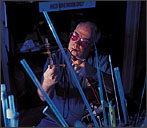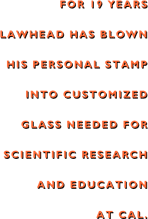

There is Waterford glass, finely cut crystal made in Ireland and exported to kings and queens the world over. There is Murano glass, its brilliant colors reflecting the creativity of Italian glass artists. And then there is Tom Lawhead glass.
The campus glassblower's made-to-order test tubes, beakers, condenser coils and other scientific creations are not grand or famous. But Waterford and Murano can't boast of important research performed with their artistry.
Lawhead can.
In the early 1960s, 15 glass blowers at Berkeley and Lawrence Berkeley Laboratory shaped and delicately manipulated glass for the specific research needs of professors and graduate students. But by the 1970s, new metals were preferred over glass for making scientific equipment.
Today, Lawhead is the only full-time glass blower left, having spent the past 18 years in Room B63 of Hildebrand Hall. There, ceiling-high bins brim with Pyrex stoppers, plugs and t-valves. Boxes of apparati needing repair nestle against the wall. Nearby, a tall, metal cabinet reveals row upon row of glass rods and tubing. Lawhead's tools -- calipers, gas torches, a vise, large lathes -- surround his workbenches, backlit by the glow of orange-blue gas flames. An oven, 1,050 degrees hot, bakes his pieces, testing their strength before they are put to scientific use.
Lawhead's shop has no shortage of work. Job orders arrive regularly from the departments of chemistry, chemical engineering, materials sciences, soil sciences and physics. He also blows glass for the UCSF Medical Center and Lawrence Berkeley Laboratory.
"We're back to the stage where researchers want to see their reactions," he said, "and you can't see your reaction in a metal vessel or a metal reactor. You have to have glass."
Researchers often bring Lawhead drawings, some of them quite unconventional, of the equipment they need. Once, a crumpled brown paper looking suspiciously like a restroom paper towel was handed to Lawhead. It contained intricate squiggles and dots resembling Egyptian hieroglyphics. From this, Lawhead was asked to create a vacuum line.
"You have to have the ability to see in three dimensions," he said, "because when they bring you a drawing, it's just on a flat surface." Lawhead often provides professors and students with a sketch of what he envisions creating. "Then I'll say, OK, do you think this will do?" he said.
Unlike artists who blow glass vases using long iron poles, much of Lawhead's work consists of using his breath and a gas torch to expand glass tubing into chambers and other utilitarian shapes. He also takes already formed glass tubing and seals it together, bends it or rounds it off.
This unusual field -- scientific glass blowing -- demands a long apprenticeship. The hot material is difficult to manipulate. And working with flames and razor-sharp glass can be dangerous. An accident Lawhead once had required 150 stitches.
He got an unexpected start in the business in 1963 while attending Indiana University. While working in the stock room to help pay for college, Lawhead happened upon the head of the campus's glass shop. The man offered to teach Lawhead the trade. "I had no idea what a scientific glass blower was," said Lawhead, who got hooked on the work, "but he took me in and trained me."
Lawhead's apprenticeship at Indiana lasted four years.
He began with learning to make straight seals and T-shaped tubes and bends, sitting for eight hours a day, just doing that. "The most experience I got was when he went on vacation and left me all by myself," he said, "so it was either sink or swim."
Before arriving at Berkeley in 1980, Lawhead also worked a stint at the Olin Chemical plant in New Haven, Connecticut.
But not all of Lawhead's creations are utilitarian, designed for the lab. Perched above his workbench is a delicate swan, its neck gracefully arched. Next to it, a chubby little bear is swinging a golf club.
"Everybody that's a glassblower generally plays around a little bit."
by Jean Smith
![]()


[Table of Contents] [Berkeley Magazine Home] [UC Berkeley Home Page]
Copyright 2000, Regents of the University of California. All rights reserved.
Comments? E-mail ucbwww@pa.urel.berkeley.edu.